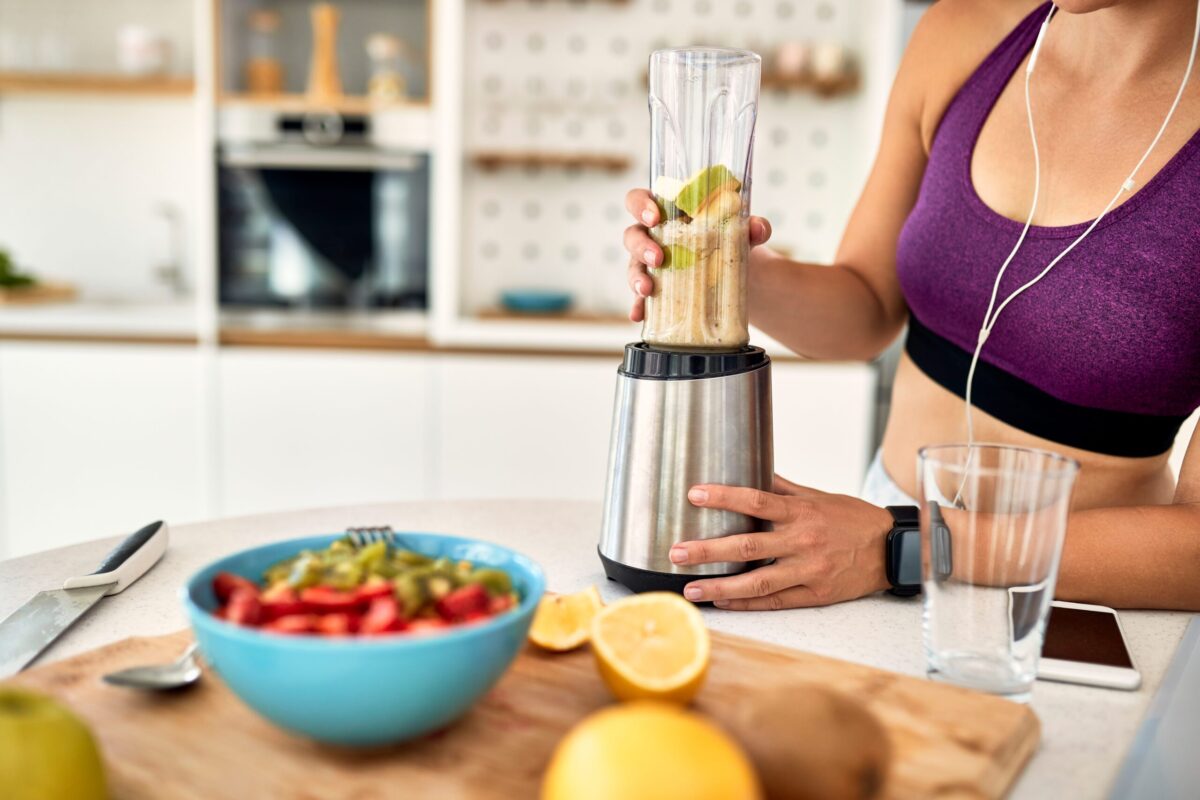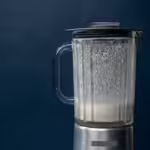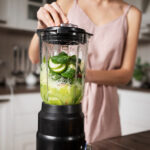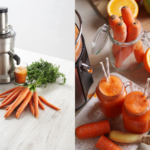“Can you use a blender as a juicer? This question mostly resonates in our minds. In the world of modern kitchen appliances, blenders and juicers are two essential tools that have revolutionized the way we prepare beverages and culinary delights. While each of these appliances serves a specific purpose, blending and juicing, they share some overlapping functionalities
In this discussion, we will explore the fascinating realm of blenders and juicers, examining their capabilities and understanding whether a blender can effectively double as a juicer to extract the nutritious goodness of fruits and vegetables.
Let’s explore the art of extracting refreshing beverages and discover the possibilities that these versatile kitchen companions offer in our pursuit of health and flavour. Join us on this journey!

Understanding the Difference between Blenders and Juicers
Functionality:
Blender: Blenders are designed to blend and liquefy ingredients by using sharp blades that rotate at high speeds. They can handle a wide range of foods, including fruits, vegetables, ice, nuts, and seeds. Blenders incorporate both the juice and fiber of the produce, resulting in smoothies and shakes with a thicker consistency.
Juicer: Juicers are specialized machines that extract juice from fruits and vegetables through squeezing or pressing mechanisms. They separate the juice from the solid pulp, producing clear and pulp-free liquids.
Output:
Blender: The output of a blender is a smooth and consistent mixture that retains all the fiber and nutrients present in the ingredients. Blended beverages are generally thicker and more filling due to their fiber content.
Juicer: The output of a juicer is a clear liquid, devoid of pulp. Juices are lighter and more concentrated, containing a higher proportion of vitamins and minerals.
Fiber Content:
Blender: Blenders retain the dietary fiber of fruits and vegetables, promoting better digestion and satiety. Fiber is essential for gut health and helps slow down the absorption of sugars, which can be beneficial for people with diabetes.
Juicer: Juicers remove the fiber from the juice, making it easier for the body to quickly absorb the nutrients. While this can be advantageous for those who have difficulty digesting fiber or need rapid nutrient absorption, it lacks the beneficial effects of dietary fiber.
Nutrient Retention:
Blender: Blending ingredients preserve more nutrients since the entire fruit or vegetable is utilized, including the skin and pulp.
Juicer: While juicing extracts a concentrated amount of vitamins and minerals, some heat and oxidation may occur during the process, potentially reducing the overall nutrient content of the juice.
Versatility:
Blender: Blenders are highly versatile and can create an array of recipes, including smoothies, shakes, soups, sauces, and dips. They can handle both soft and hard ingredients, allowing for a diverse range of culinary creations.
Juicer: Juicers are specialized in juice extraction and are limited to fruits and vegetables. Some juicers may not be able to process certain ingredients like leafy greens, nuts, and seeds.
Waste:
Blender: Blenders utilize the entire fruit or vegetable, resulting in minimal waste.
Juicer: Juicers produce pulp as a byproduct, which can be repurposed for other culinary uses or composted. However, some individuals may find the generation of pulp waste less environmentally friendly.
Texture:
Blender: Blended beverages have a thicker and smoother texture due to the inclusion of fiber and pulp.
Juicer: Juices have a clear and liquid consistency, lacking the pulp and resulting in a lighter mouthfeel.
Ease of Cleaning:
Blender: Blenders are generally easier to clean since their design involves fewer parts than juicers.
Juicer: Juicers can have more components that require thorough cleaning, especially those with smaller nooks and crannies.
Cost:
Blender: Blenders are often more affordable than juicers, making them a budget-friendly option for many households.
Juicer: Juicers, especially high-quality ones, can be more expensive due to their specialized juicing mechanisms.
The Pros and Cons of Blenders:
Blenders have picked up colossal ubiquity for their flexibility and ease of utilisation. One of the key focal points of employing a blender is that it holds the dietary fiber of natural products and vegetables, advancing superior assimilation and satiety. Smoothies made in blenders are too filling due to the fiber substance, making them perfect as dinner substitutions or solid snacks. Furthermore, blenders can handle a wide extend of fixings, counting verdant greens, nuts, and seeds, permitting the creation of nutrient-rich refreshments.
However, the main drawback of using a blender for juice extraction is the presence of pulp. Some individuals may find the pulp texture undesirable, and it can be particularly challenging for people with certain dietary restrictions or digestive issues. Additionally, the blending process can introduce some oxidation, potentially reducing the shelf life of the blended drink and affecting the overall nutrient content.
The Pros and Cons of Juicers:
Juicers excel at providing pure and pulp-free juices, making them a preferred choice for those seeking a cleaner and lighter beverage. The extraction process efficiently separates the juice from the fiber, delivering a concentrated dose of vitamins and minerals without requiring significant digestion. Juices are also a fantastic way to quickly consume a variety of fruits and vegetables, especially for individuals who struggle to consume them in their whole form.
However, one of the drawbacks of using juicers is the waste generated in the form of discarded pulp. This pulp is nutrient-rich and can be utilized in other culinary applications, such as baking or composting, but it remains a consideration for environmentally conscious individuals. Furthermore, juicers may struggle with certain ingredients like nuts and seeds, limiting the diversity of potential beverages.
Can You Use a Blender as a Juicer? Yes!
Blenders can be used as makeshift juicers to extract juices from fruits and vegetables. While they may not be as efficient as dedicated juicers, they can still do a decent job. Here’s a step-by-step guide on how to use a blender as a juicer:
Step 1: Gather your ingredients
Collect the fruits and vegetables you want to juice. Wash them thoroughly to remove any dirt or pesticides. You can use a variety of fruits and vegetables like oranges, apples, carrots, celery, kale, and more, depending on your taste preferences.
Step 2: Prepare the fruits and vegetables
Peel and chop the fruits and vegetables into small pieces. Removing the peels may be necessary for certain produce with thick or bitter skins, but for others, you can keep them on for added nutritional value.
Step 3: Add the ingredients to the blender
Place the chopped fruits and vegetables into the blender’s jug. Be mindful not to overload the blender, as it may affect the blending process and the quality of the juice.
Step 4: Add a small amount of liquid
To help the blending process, add a small amount of liquid. Water, coconut water, or any other beverage of your choice can be used. The amount of liquid you add depends on how thick or thin you want your juice to be.
Step 5: Blend on a low setting
Start the blender on a low setting to break down the fruits and vegetables without creating too much heat, which could affect the nutrient content of the juice.
Step 6: Gradually increase the speed
As the fruits and vegetables start to blend, gradually increase the blender’s speed to its highest setting. Continue mixing until you achieve a smooth and consistent texture.
Step 7: Strain the juice
To remove the pulp and fiber from the juice, place a fine-mesh strainer or a nut milk bag over a large bowl or jug. Pour the blended mixture through the strainer, using a spoon to press the pulp and extract as much juice as possible.
Step 8: Press the pulp
If using a nut milk bag, gather the edges and twist them to squeeze out any remaining juice from the pulp. This step is essential to ensure you get the most juice out of your blended mixture.
Step 9: Transfer and serve
Once you have strained and pressed the juice, transfer it to a glass or a bottle. You can also add ice cubes or chill the juice in the refrigerator before serving for a refreshing experience.
Step 10: Clean the blender
Don’t forget to clean the blender immediately after use. Rinse it with warm soapy water, and if there are any stubborn residues, use a brush to scrub them away.
Remember that using a blender as a juicer may not yield the same results as a specialized juicer, as some pulp and fiber may still remain in the juice. However, it’s a great way to make fresh juices at home if you don’t have a juicer. Enjoy your nutritious homemade juice!
Conclusion
We have compared juicers and blenders and with the help of this blog hope that you have clarification for the query “Can you use a blender as a juicer “. In conclusion, blenders and juicers offer special functionalities within the world of cutting-edge kitchen machines. Whereas blenders can serve as improvised juicers, creating fiber-rich juices, devoted juicers exceed expectations by giving clear and pulp-free fluids. Understanding their personal qualities and drawbacks engages us to form educated choices in our interest of well-being and flavor.











